|
Tena and the Jungle: next episode in the Galapagos Saga 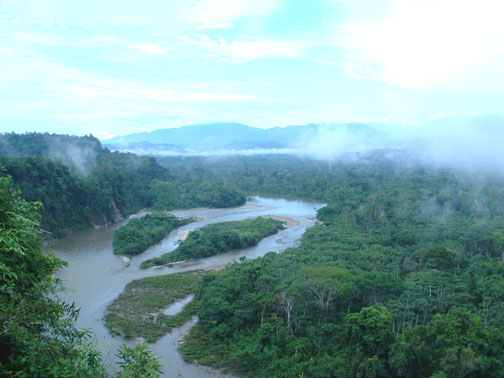
|
|
Most of the smaller pictures are "clickable" to see larger versions. Use the "back" button on your browser to return to this page. |
|
Tena is on the fringe of the jungle, the nearest true rainforest to the capital, and with our limited time we didn't think we could go much deeper in. From the town itself we booked a 3 day jungle tour, which, although well organized and good in many ways, didn't take us far enough in to see very much wildlife. It was mainly scenery, rivers, gorges, rainforest canopy and Indian villages, with demonstrations of such things as traditional crafts, cooking and medicinal uses of plants. Compared to the Costa Rica rainforest it was a bit disappointing - even depressing. The Indian villages here are a bit shabby and Westernised, with people wearing shorts and trainers and T-shirts and just maintaining enough of their traditional way of life to keep up the appearance of theme park tribalism. It seemed very unconvincing and manufactured. The real reason that there are so few animals, apart from some habitat destruction, is that the Tena Indians traditionally hunt and eat practically everything that lives in the jungle, and animals like monkeys, tapirs, bears and agutis have very wisely moved elsewhere. There are organizations trying to restock the Tena rainforests, but it's a losing battle because even though the Indians now tend chickens, pigs, cattle and goats like the Western settlers, they simply won't stop hunting for the wild meat that they believe to be better tasting. Preserving traditional village life and restocking the rainforests with native wildlife are two conflicting aims. It worked when the human population was small and the hunters had spears rather than guns, but those days have gone forever. |
 Shangri-La, high above the river on top of a 100 metre cliff |
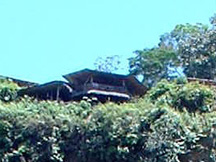 Enlargement to show buildings perched on cliff-top | 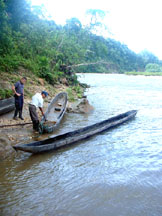 Canoes on the Rio Napa : |
|
We slept in huts at a place called Shangri-La on the top of a 100 metre cliff overlooking the Rio Napa river, a fair-sized Amazon tributary. The view was amazing. We went trecking, rafting, swimming in the river itself, in lagoons and beneath waterfalls and had a generally very good time, but the only creatures we saw were a few lizards, a bat that very kindly flew into the hotel bar and landed on the counter, and the tame coati named Pepe who lived permanently at Shangri-La when he wasn't visiting his family in the forest. I got Jean to take a few pictures of him sitting on my shoulder or curled up with me in the hammock. He and I became very good friends. In case you are wondering a coati is generally similar to a raccoon but with a longer nose and a tail that tends to stick up into the air when it walks. They live in big social groups in the jungle and are generally quite timid. Pepe must have been the exception. |
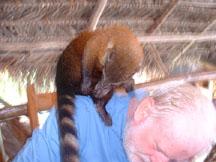 Pepe the coati on David's shoulder |
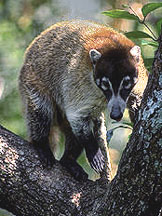 One of Pepi's relations in a more natural setting |  Little bat that flew in to Shangri-La |
|
Most evenings if we were near enough to an Internet Cafe we reported back to our friends (and sent a copy to ourselves also) with details of how the holiday was going. This narrative is based on those day-by-day accounts. One of the most incongruous sights we saw were beautiful young Indian girls in full national costume using the Internet alongside the tourists. Ecuador has a 90% literacy rate and the younger generation is just as computer savvy here as anywhere else. It's just that somehow you don't expect it, at least not while they are wearing clothes out of a Channel 4 "missionary" period drama. Our three days jungle tour was very good but very strenuous. Our group consisted of seven people including us: a nice Swedish couple, a nice German couple and an English girl. The others were all young and much fitter then us. On the first day we were supposed to hike up to three waterfalls but after the first we were panting, worn out by the speed of the walk, the heat and the altitude. We opted out and walked back on our own even though we were soaking wet with the waterfall. In a hot climate It doesn't matter when you're wet, in fact it's quite pleasant. In the afternoon we had a nice relaxed walk and learned about the plants of the forest and their uses. We had been provided with an English translator who was in fact from the Slav Republic and married to a local woman. You meet some interesting and unusual people in a place like this. |
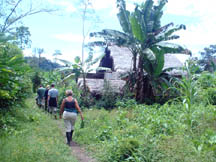 A hut in the village |
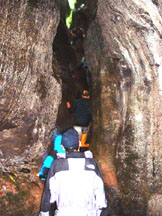 Getting through a gorge |  Group member Sue waits to go in |
|
In the night it pelted with rain and there was spectacular thunder and lightning right overhead. In fact we had a lot of amazing storms. On the second day it had cleared up and we went for another strenuous walk which involved walking along narrow gorges by putting a leg on each side, or legs on one side and hands on the other. At one point Jean fell and landed in water nearly up to her waist - fortunately she chose a place where the drop wasn't too great. Another time we had to balance over a waterfall with a 10 ft drop below us, but we all survived and enjoyed it. Some of the gorge was inside caves full of bats, which flew around and squeaked with annoyance at being disturbed. We also saw our first little frog, which our guide pretended to eat. Our guide was a very pleasant Indian man who must have been over 60 but was incredibly fit and strong and very considerate helping us (especially Jean) through the tricky bits. After the first day our own fitness improved a bit and we did not chicken out of any other activities. |
 Our guide makes rope from leaves |
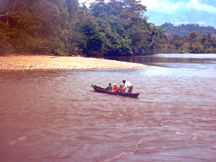 Crossing the river in threes |  Pico de Loro plant |
|
On the third day we went for a walk along a path by the river to an Indian village. It involved crossing the river, which was quite fast flowing, in a long canoe. Again our strong guide paddled and punted us across three at a time. The village, as I have said, was very basic and crude. The children hung around and though they were ragged seemed healthy and happy enough. There was a school hut with a teacher and a couple of kids in attendance, but it didn't appear to be compulsory. All the villagers wore ragged Western clothes but again seemed contented enough. |
 Our guide tells us about making a fish trap |
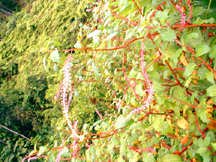 Jungle plants |  Large millipede |
|
In the afternoon we did "tubing" down the river, which involved roping 5 lorry size inner tubes together to form a crude raft, piling 8 people onto it, and shooting down the river and over some rapids. Again our Indian guide had a paddle and steered us. It took about 2 hours and we got very wet but it was good fun. We went back, had dinner and were then driven back to our hotel in Tena. The only thing we weren't keen on during this jungle diversion was the food which was always a bit tough. The cook didn't seem to take long enough to cook the meat properly. I was also a bit uneasy about the attitude of the (Indian) staff at Shangri-La towards wildlife. A little bat that inadvertently flew into the hotel lobby and landed on the front desk was held up rather roughly with wings outstretched and displayed to the guests. The staff didn't seem to have much concept of what might be stressful to the animal. I also saw the tame coati Pepe handled quite harshly on a couple of occasions and there were continual jokes about eating him, and about the tough meat being 'bushmeat' (monkey meat). Although spoken in fun I think remarks like that were quite revealing about people's underlying attitude to the native wildlife. I couldn't help contrasting it with the reverence for wildlife that was so prevalent in Costa Rica, and wondering if the Ecuadorian people were really fit to be in charge of a planetary treasure as precious as the Galapagos National Park, but these fears at least were later set to rest. The next day we went to a kind of an animal and botanical park on an island in Tena. It wasn't marvelous but was quite nice to wander around at a slower pace. In the afternoon we got a bus to a place called Puyo. |